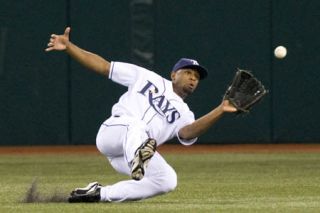
Cognition
The Embodied Cognition of the Baseball Outfielder
Sometimes the best way to solve a problem is to move in just the right way
Posted July 16, 2012
Embodied cognition is the theory that our behaviour comes from more than just the brain. The way we move, the types of bodies we have, and how we perceive the world all work with the brain to create our behaviour in real time. We might use our movements, for example, to solve problems that we could never solve with just brain power. Scientists studying embodiment therefore look for examples of people perceiving and acting in particular ways to solve tasks. My favourite example of this kind of research is the outfielder problem because, like Big Dog, the outfielder problem is a handy example that illustrates some of the key principles of embodied cognition.
Catching a fly ball is harder than it looks
The problem is this: how does a baseball outfielder know where to go so as to be in the right place, at the right time, in order to catch a fly ball? It turns out that this is surprisingly hard to do. Normally, when something is coming towards you, it seems to get bigger as it gets closer. (Hold your hand in front of you and move it towards you to see what I mean.) The baseball, however, is too small and too far away most of the time so this "looming" effect is just too difficult to see. A trained outfielder makes this catch look easy, though—so how are they doing it?

Embodied cognition in action
If all you had was a brain...
One solution is to mentally predict where the ball will land. Fly balls are an example of projectile motion. They go up and come down along a curved, arcing path called a parabola. How far the ball goes mostly depends on how hard they were hit and at what angle they went up—there's no engine or anything to keep pushing them along. As physics goes, the maths of projectile motion is fairly straight-foward.
If the outfielder watches the batter hit the ball, and can see the initial speed and angle, in theory they could do that math in their head and predict where the ball was going to land. The fielder could then run (in a straight line) from where they are to where the ball will land.
This idea runs into the same basic problem however—when the ball is hit, the outfielder is a long way away and it will be hard to see exactly how the ball is moving to begin with. The inevitable small errors in what you perceived would then cause big problems—remember how Asimo failed completely at stairs with just a tiny miscalculation. So with just a brain, the outfielder problem has no reliable solution—the outfielder shouldn't be as good as they are!
But if you add a body that can move...
If the outfielder simply stands and watches the ball, they'll see it fly up in the air along a curved path, slowing down due to gravity, reaching a peak height and then speeding up again as it falls to earth. If, however, they start to move, then what they'll see is a mix of their motion and the ball's motion. If, for example, the outfielder was to run in a curved path that mirrors the curved path of the ball, the motions would cancel out and the ball would look as if it were tracing out a straight line. The same is true with the speed—if the outfielder were to speed up and then slow down at just the right times, the ball would look as if it was moving at a constant velocity.

Dogs catch Frisbees using the same embodied strategy
It turns out that if an outfielder were to move to make the ball look this way, then they would just so happen to end up at the right place at the right time to catch the ball! This is a side effect of the fact that the ball is moving along a parabola, and if you look at how outfielders move, they do indeed follow these kinds of curved paths with varying speed, rather than the straight line you might expect if they were predicting where the ball would land. Interestingly, so do dogs!
Lessons for cognition from the baseball outfielder
Embodied cognition solutions look quite different from the traditional cognitive theories. Here, the outfielder is simply moving so as to make the world appear a certain way now, which leads them to be in the right place later. This is what researchers refer to as a perception-action loop, and this loop has replaced the need for complex mental effort; better, it's so easy to use even a dog can learn it.
Another key feature is that the outfielder can literally see how well they are doing all the time. If the ball isn't quite moving correctly the outfielder can simply change their movements to fix the problem. If they can't move so as to make the ball look right, then that tells them they cannot reach the ball in time and they should get ready to take it on the bounce so that they can fire it back into the infield without any delay. Everything the fielder needs to "know" to produce reliable, successful behaviour is present in the perception-action loop.
Finally, the resources required to solve this problem are not just in the head—they're spread all over the field! The motion of the ball, the motion of the fielder, and how those interact don't just help a little bit, they are all vital parts of the solution. This is what embodied cognition researchers mean when we say "it's not all in the head", and perception is the glue that ties it all together.
This embodied solution is efficient and cheap (no complex mental simulations of physics required) and it produces reliable results under a wide variety of environmental conditions. It's no wonder, really, that good outfielders have embraced the embodied way of life.
Further Reading
Some interesting papers on this topic:
McBeath, M.K., Shaffer, D. M., & Kaiser, M. K. (1995). How baseball outfielders determine where to run to catch fly balls. Science, 268 (5210), 569-73. (Download this article)
Shaffer, D. M., Krauchunas, S. M., Eddy, M. & McBeath, M. K. (2004). How dogs navigate to catch Frisbees. Psychological Science, 15(7), 437-441. (Download this article)
The Outfielder Problem on Notes from Two Scientific Psychologists (I review some of the empirical work in more detail here).



